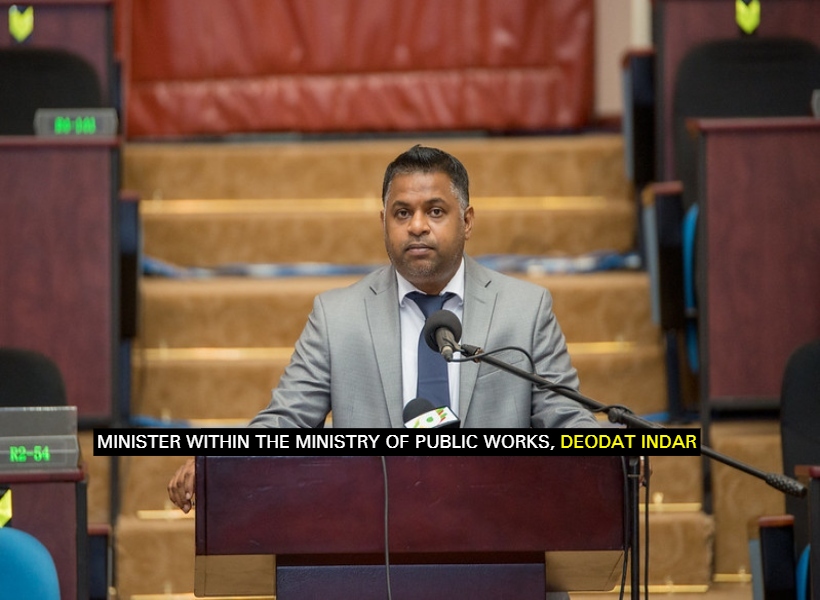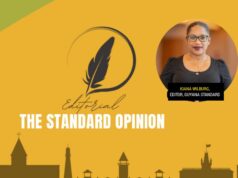Guyana, like the rest of the world, is already experiencing the effects of climate change. In fact, world leaders have accepted that perilous times are ahead if enough isn’t done to both minimize the cause, and combat the effects, of climate change. Cognizant of their responsibility, many countries are now grappling to figure a way forward. Meanwhile, Guyana is already on the path towards sustainable development even as it aims to transition to renewable forms of energy and maintain its forest as outlined in the draft Low Carbon Development Strategy (LCDS) 2030.
This is essentially what Minister within the Ministry of Public Works, Deodat Indar told farmers, fishermen and members of Region Three’s academic community who gathered yesterday at Leonora High School as government continues consultations on the draft LCDS 2030.
The Minister conveyed that the LCDS is no superficial or decorative document but one intended to be used by government to charter a way forward to a Guyana that subscribes to international standards for the environment while securing development for its people.
Indar referenced the fact that the International Energy Agency has already stated that the world needs to avoid temperature rise above 2.5 °C over pre industrial levels or face irreversible damage. “It means that if the earth heats above 2.5 °C by 2050, the damage will be irreversible. Eco-systems will be destroyed and we cannot undo it,” he explained.
The Minister said that as a result, the world has come together and outlined a number of things to be done to reduce harmful gases being released into the atmosphere.
Referencing the United Nation’s goal for countries to be net zero by 2050, Minister Indar said, “Guyana is already a net zero emitter because we have a huge forest and we maintain 99 percent of it. Yes, we do have forestry, we do have mining and different agriculture activities in communities but we make sure it is done in a sustainable manner.”
Minister Indar noted that Guyana has a no clear-felling policy that applies to both forestry and mining. “In forestry, if you harvest from one area you cannot go back and harvest there.”
He said it is strategies like that that allows Guyana to maintain its forest that has the capacity to sequester about 19.5B tons of carbon dioxide. Indar went as far as to say that Guyana’s forest has the capacity to sequester the annual emissions of three European countries and that’s just the inland storage. He noted that Guyana also has mangroves, in the wetlands, that have the capacity to store four times as much carbon as the inland forest.
Minister Indar said that the LCDS is designed to put Guyana as a model for the rest of the world with four main objectives. These are to create new incentives for a low-carbon economy; to stimulate growth: clean energy and low carbon development; to protect against climate change and biodiversity loss and to align with global climate and biodiversity goals.
Zeroing in on the goal to transition to clean and renewable forms of energy, Miniter Indar noted that the Guyana Power and Light (GPL) company uses Hevey Fuel Oil (HFO) which burns and emits a lot of harmful gases. He said that the LCDS sets out a transition strategy away from use of HFO and towards a clean energy mix.
The energy matrix to which he refers depends on different sources of energy from hydro plants, solar panels and gas. While natural gas is not a renewable form of energy, Indar was keen to note that natural gas gives off half as much harmful pollutants as HFO.
Minister Indar said that the natural gas plant—to be erected at Wales—will output 250megawatts. While, the Amaila Falls Hydro plant will deliver 165megawatts of electricity. “With that and the other renewable energy grid systems we are putting in Essequibo and Berbice to tie in and provide for the country, we will be able to move away from heavy fuel,” said Indar. He added, “Guyana is therefore on a path to producing energy in the most efficient way, cost effective way and environmentally friendly way. The rest of the world is grappling with how they are going to transition, Guyana is already on that path.”
Turning his attention to another goal, to protect against climate change and biodiversity loss, Indar reminded that Guyana is a low-lying coastal state. He said that with rising water level, if adaptation levels are not put in place to stop flooding, it spells disaster for us.
The Junior Public Works Minister mentioned a study conducted by the International Renewable Energy Agency which states that if appropriate measures aren’t taken, by 2100, there will be at least a 0.56-meter rise in sea level. Guyana, like other low level costal states would be affected if nothing is done. Therefore, it is necessary to protect against climate change and implement adaptation measures.
Then Minister Indar spoke about the aim to align with global climate and biodiversity goals. He said, “this is simply about aligning Guyana with the rest of the world but because of the strategy we are already leading.” He noted that the strategy is advocating for a strong global carbon tax and reduction in subsidies on fossil fuel. He also said that Guyana intends to market its carbon credit on the international market.
Indar encouraged those gathered to pay attention to the technical presentation delivered by LCDS consultant, Venessa Benn as he stressed, “Our government is moving in this direction and we want to make sure we consult with you, you understand it, know why we are doing it, question it and add to it so it can become better as we go along.”













